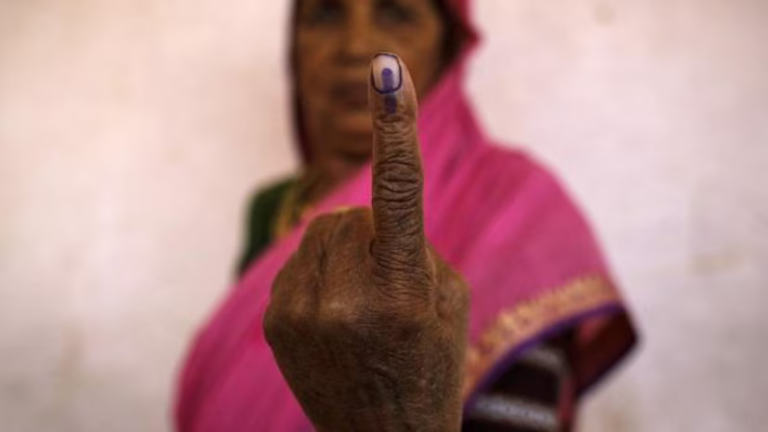India’s massive, twice-a-decade exercise in democracy is once again leaving its mark on the country’s people, in the form of purple-streaked index fingers. The Election Commission uses indelible ink, or “voter ink,” to prevent fraud or duplicate votes. Once a voter arrives at the booth to cast their ballot and has their ID verified, the ink is painted across the top of their left index finger, leaving a stain that can take up to two weeks to wash off. Let’s delve deeper into the significance, history, and impact of this unique practice.
The Tradition of Voter Ink
The practice of using indelible ink during elections in India dates back to the country’s first general elections in 1951 and 1952. At that time, with no systematic registration of births or identity documents, preventing impersonation and double voting was a significant concern. The idea of marking voters with indelible ink was proposed to ensure a fair and transparent electoral process.
A Symbol of Democracy
Since its inception, the use of indelible ink has become synonymous with Indian elections. “Right from the prime minister to the most common person, everybody flashes their (marked) finger,” said K Mohammed Irfan, managing director of Mysore Varnish and Paints Limited (MVPL), the state-owned company that exclusively makes and distributes the ink. It has become a mark of democracy, proudly displayed by celebrities, film stars, and citizens alike.
The Manufacturing Process
MVPL, based in Mysuru, Karnataka, is responsible for producing the indelible ink used in India’s elections. The company has been preparing millions of ink vials for distribution ahead of each election. The tightly guarded formula, which includes the chemical compound silver nitrate, has remained unchanged since 1951. Each vial contains enough liquid to mark approximately 700 voters.
Ensuring Integrity in Elections
The use of indelible ink serves as a crucial tool in maintaining the integrity of India’s electoral process. It prevents fraud and ensures that each voter can cast their ballot only once. More than 960 million people are eligible to vote in India’s elections, making it the world’s largest democratic exercise.
Historical Significance
In a country with diverse demographics and a history of mass movements and migrations, ensuring fair elections posed unique challenges. Ornit Shani, author of “How India Became Democratic: Citizenship and the Making of the Universal Franchise,” explains that the introduction of indelible ink played a vital role in addressing these challenges. It not only prevented fraud but also symbolized the core value of the equality of the vote.
MVPL: Beyond Indelible Ink
While MVPL is primarily known for producing indelible ink, it also serves as a paint supplier and has a rich history dating back to 1937. The company’s contributions extend beyond elections, supplying various products, including paint for public transport sectors.
Global Impact
The appeal of India’s indelible ink has spread beyond its borders. MVPL supplies the ink to more than 35 countries, including Ghana. However, while India continues to rely on the ink for its elections, other nations like Ghana are opting for biometric verification methods.
Cultural Relevance
The practice of marking voters with indelible ink aligns well with Indian cultural practices, according to Mukulika Banerjee, an associate professor of anthropology at the London School of Economics. In a culture where body decoration, such as henna tattoos, is common, the marking of the finger fits seamlessly.
Peer Pressure and Civic Duty
Banerjee highlights an unintentional effect of marking voters with ink: creating an environment of peer pressure. In India, individuals often check each other’s fingers on polling day, and the absence of the mark may prompt questions about why someone hasn’t voted. This peer pressure, combined with the influence of celebrities and athletes posting their ink-stained fingers on social media, encourages voter turnout.
Future Outlook
Despite advancements in technology, the practice of using indelible ink in Indian elections shows no signs of fading away. It remains a symbol of democracy and a reminder of the importance of civic duty. As Mukulika Banerjee notes, the aspirational aspect of emulating heroes who proudly display their ink-stained fingers contributes to its enduring appeal.
Conclusion
India’s use of indelible ink during elections is more than just a practical measure to prevent fraud; it is a symbol of democracy deeply ingrained in the nation’s political culture. Over the years, it has become a tradition that transcends social and cultural boundaries, with its impact felt not only within India but also across the globe. As the country continues to evolve, this simple yet effective method serves as a reminder of the power and significance of each individual’s vote in shaping the world’s largest democracy.

